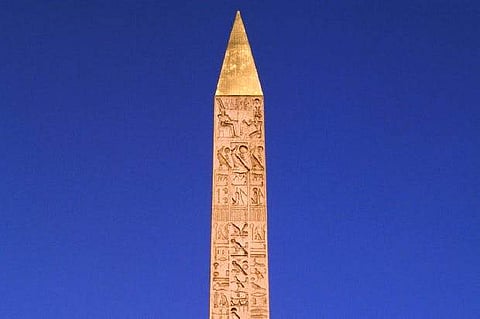

Once arresting and grandiose, obelisks are typically elongated, four-sided structures with a pyramidical shape capping it as it tapers towards the top. They are one of mankind’s oldest built forms and have multiple purposes. The origin of obelisks are quite mysterious and various cultures have varying and colourful accounts as to how they came to be. While most obelisks are monolithic (carved out of a single stone), some are built in the traditional shape, except that brick and mortar structures are used over a scaffolding of steel. Obelisks initially served as ancient Egyptian religious symbols and may have been merely a tapering pillar that served to elevate a representation of the pyramid that is ubiquitous to Egyptian culture.
The oldest existence of obelisks was recorded in hieroglyphics from the ancient Egyptian civilisation. Used to commemorate the reign of a Pharaoh or to honour them in death, they were mostly topped with electrum — a gold and silver alloy. Other cultures may have chanced upon the pattern while trading with the Egyptians or from the accounts of court scribes and travellers. Many obelisks were even transported from Egypt to Rome and gave rise to the proliferation of the form all over the European landscape and its colonies. The imitation of this form went as far as Judaea and Constantinople, but wasn’t popular in the Americas, Australia or the southern and eastern regions of Asia until much later. The obelisk tribe showed a sudden increase in contemporary history though. There is an interesting pattern to observe here — most of these rose up as memorial stones after the great wars that were waged worldwide.
They initially used to serve also as sundials and calendars. Explorers and geographers of the past used them (often erroneously) to measure and mark degrees to try and calculate the distance between lands as well as the circumference of Earth. These giants continued their journey all over the world; the simple, plain stone monolith that once flanked the entrances of Egyptian temples and the burial sites of Pharaohs had by now reached the Coronation Park in New Delhi where it marked the proclamation of Queen Victoria as the Empress of India. Another one rose up as the Washington Monument in the National Mall strip in the USA — this one is the memorial monument itself and is a building mostly made of marble and granite. There are stairs and elevators inside for the steady stream of visitors who may want to go up to the gallery at the top.
Be it commemorative or decorative or a child’s flight of fancy with sand on a seashore, this symbol of phallic architecture is a throwback to the tower of Babel — a testament to our eternal desire to look up to the skies and rise high. They have made their way into popular culture as well — wonder where the affable sidekick in the Asterix and Obelix comics got his name from? Nothing to get conspiracy theories brewing like casting a popular obelisk in a major role in a thriller novel by Dan Brown. By now there are surely millions of obelisks around the world, large and small, that have become antiquities and pieces of art, becoming surfaces themselves and lending their façades to artists who have carved them into standing sculptures while retaining the classical shape. Some artists draw and paint murals on them, resulting in a gargantuan four-sided slab of art.
